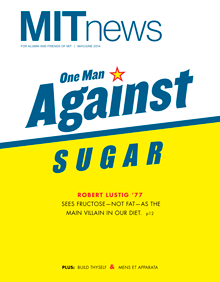Letters
AI, Again
There are reasons to be optimistic about the prospects for the newly formed Center for Brains, Minds, and Machines (“Mens et Apparata,” May/June 2014), but I wonder if the participants will be able to resist the urge to oversell the product the way their forebears invariably did. Each new bandwagon, from cybernetics to perceptrons to automated theorem proving to expert systems to connectionism to situated robotics to complex dynamical systems, has been heralded as an epic breakthrough by the proponents. So far, these have proved to be useful wrinkles at best.

The history of AI is marked by the (quite reasonable) pattern of trying the “easy” ways first—just in case one of them pays off. And since the early tries were both brilliant and determined, we can conclude quite confidently that none of the paths already explored will deliver true AI. Too brittle, too hierarchical, too logical, too “efficient”—properties more or less dictated by the puny size (in retrospect) of the computers used to run the models. The classic “giant” programs of the 1970s and ’80s could run on a virtual mainframe simulation you could download to your iPhone.
Which neuroscientifically “realistic” models should we opportunistically champion in this new round of play? Again, let’s try the low-hanging fruit first, instead of trying to model every single neuron (and every glial cell!); let’s see if today’s probabilistic approaches can deliver more flexible and robust intelligence. There are hopeful signs, and it’s great to see neuroscientists and computer scientists and psychologists closing in on each other’s domains, but perhaps once again we’ll come to recognize embarrassing limits in models many orders of magnitude more detailed and realistic than the early models.
My hunch, for what it’s worth, is that we have to invest in models rich enough to recognize “selfish neurons” as somewhat autonomous micro-agents, trying to find work to sustain themselves, if we are to overcome the rigidity of the “politburo architectures” (Eric Baum’s fine phrase) that have reigned to date. Time will tell.
Daniel Dennett
Center for Cognitive Studies
Tufts University
Lauding Lustig for Taking Action
One of the persistent questions regarding the work of Dr. Robert Lustig described in your article “One Man Against Sugar” (May/June 2014) is whether being a good actor is a prerequisite for being a good pediatrician: I’ll bet the kids love him as much as his YouTube audience does, and your article painted a nice personal portrait of his genuine human skills while it covered the high points of the sugar and fructose debates. Throughout my training, some of the best listeners and most engaging physicians were pediatricians, capturing the hearts and minds of even reluctant children and parents.
Increasing liver disease rates among children will be reversed only when more physicians attend to the physiology pointed out by Lustig: because fructose becomes liver fat, reducing fructose might reduce hepatic fat stores. I take the advice to heart in my own nutritional work with patients, both adult and pediatric. In suggesting dietary changes, I have come to see another dark side of fructose. Perhaps because fructose is sweeter than other sugars—and because it peaks and subsides more quickly—I have seen people cling to their fruit and fruit juices, craving them as avidly as one might crave a soda. Your article mentioned that we have always enjoyed the sugar in fruit, but today’s fruit, which has been cultivated for maximal sweetness, should be considered “added sugar” compared with heritage fruits, and it should be parceled out as stingily as other sweet treats.
Although Lustig has been criticized for taking action without a firm basis in fact, I believe that he should instead be lauded for taking action promptly. Quick action is appropriate in a medical emergency, and our children’s waistlines indeed constitute an emergency. If he were recommending hazardous medications, I would criticize him as well, but let’s remember that his treatment protocol recommends a real-food diet low in sugars and rich in vital nutrients. Prescribing meat, fish, eggs, healthy fats, whole milk, and vegetables is hardly a hazardous intervention and is certainly worth testing given the urgency of the present situation.
Deborah Gordon, MD
Ashland, Oregon
Keep Reading
Most Popular
Large language models can do jaw-dropping things. But nobody knows exactly why.
And that's a problem. Figuring it out is one of the biggest scientific puzzles of our time and a crucial step towards controlling more powerful future models.
The problem with plug-in hybrids? Their drivers.
Plug-in hybrids are often sold as a transition to EVs, but new data from Europe shows we’re still underestimating the emissions they produce.
Google DeepMind’s new generative model makes Super Mario–like games from scratch
Genie learns how to control games by watching hours and hours of video. It could help train next-gen robots too.
How scientists traced a mysterious covid case back to six toilets
When wastewater surveillance turns into a hunt for a single infected individual, the ethics get tricky.
Stay connected
Get the latest updates from
MIT Technology Review
Discover special offers, top stories, upcoming events, and more.